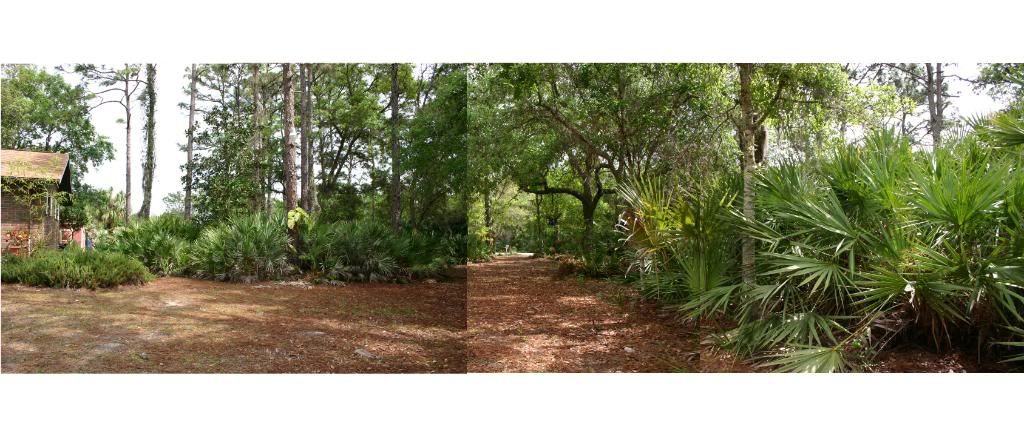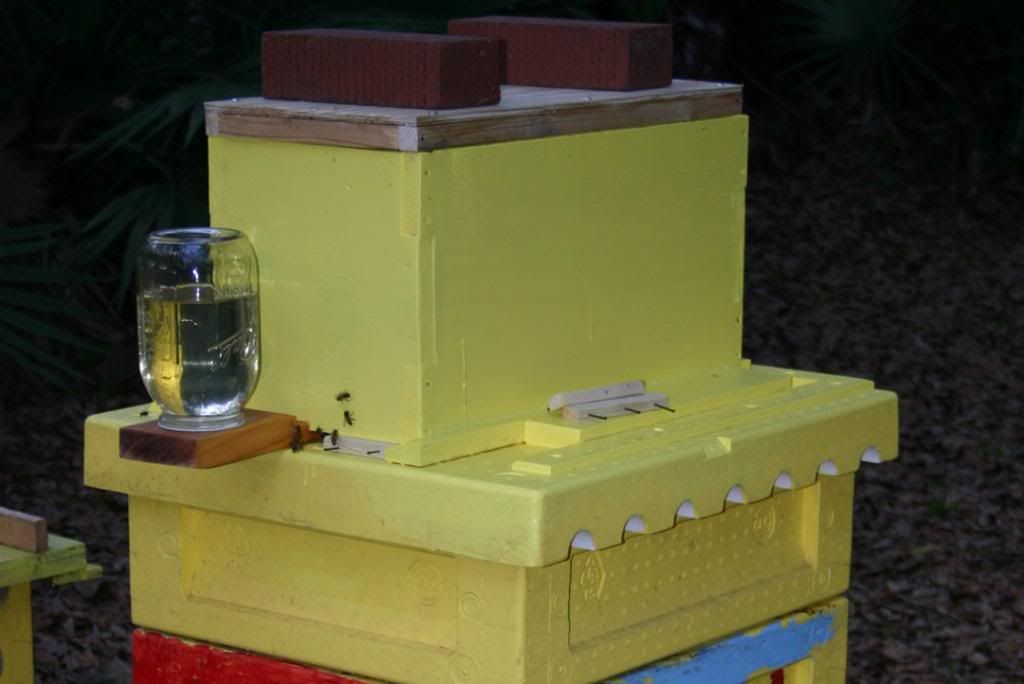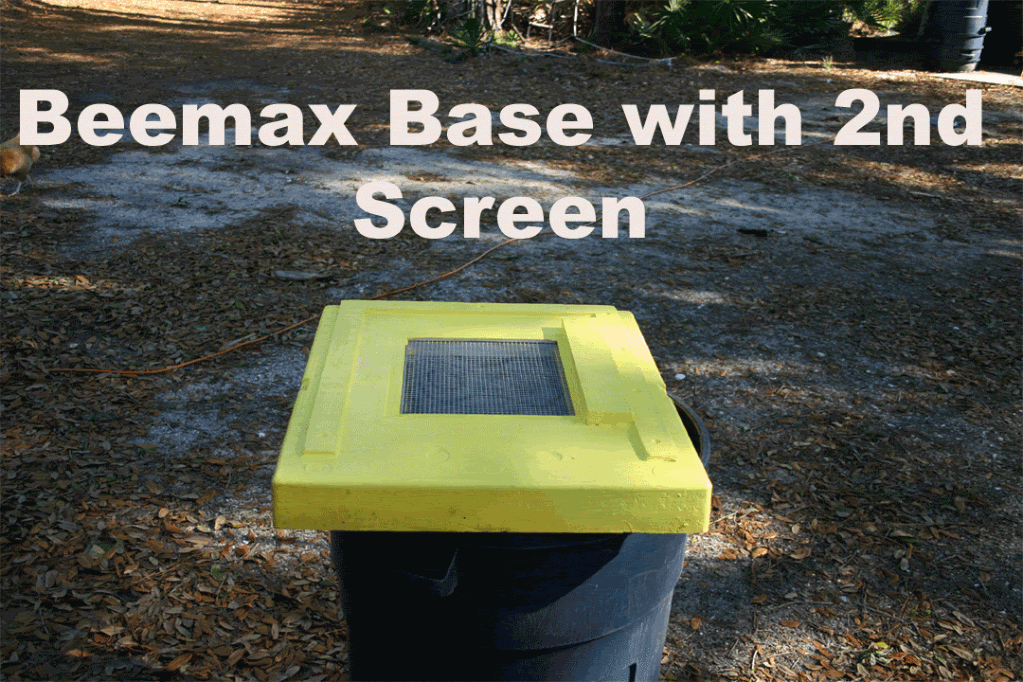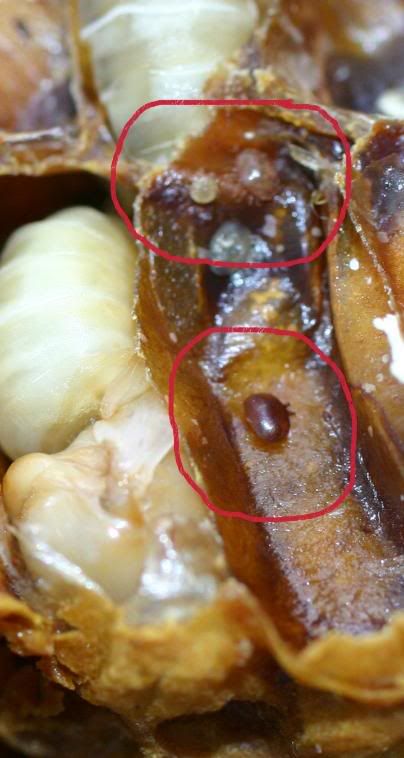
 I can’t find a queen to save my life, but I can always see the tell tales that there is one. The down under Queen has been doing her job in her new home for about 10 days, and is plenty evident by the capped and uncapped brood. The Nuc is on its way to being independent, and I performed a two day move to attempt to populate the TBH. Maybe I’m being a little inpatient, but I wanted to see bees in the TBH which I build.
I can’t find a queen to save my life, but I can always see the tell tales that there is one. The down under Queen has been doing her job in her new home for about 10 days, and is plenty evident by the capped and uncapped brood. The Nuc is on its way to being independent, and I performed a two day move to attempt to populate the TBH. Maybe I’m being a little inpatient, but I wanted to see bees in the TBH which I build.
On day one I inspected the Nuc, lifted it and placed it over some window screen. After sunset, when I was positive that all the bees would be inside, I closed the entrance. The next day I prepared the TBH by placing 7 bars with a started strip, removed the 1st bar, and place the bar that has an entrance for the bees to enter the TBH from the Nuc. Then I moved the Nuc off Hive #1, replaced the cover on the hive, and used the screen I placed the day before to keep the bees in as I lifted the Nuc off the double screen. The Nuc moved a total of 3 feet east, 1 foot south, and rotated the entrance 180 degrees. Right now the Nuc has the original entrance and one on the top bar hive.
The next day I prepared the TBH by placing 7 bars with a started strip, removed the 1st bar, and place the bar that has an entrance for the bees to enter the TBH from the Nuc. Then I moved the Nuc off Hive #1, replaced the cover on the hive, and used the screen I placed the day before to keep the bees in as I lifted the Nuc off the double screen. The Nuc moved a total of 3 feet east, 1 foot south, and rotated the entrance 180 degrees. Right now the Nuc has the original entrance and one on the top bar hive. I wanted to keep the Nuc’s entrance close, but as I slowly pulled the screen away, the entrance reducers fell off, and before I knew it the bees poured out of the Nuc and began orientation flights, so I decided to let them be as you see it. Maybe I’ll close the top entrance soon, maybe I won’t. Either way, the bees in the Nuc should move down looking for more room soon enough. My hope is that they do it in a month. I would like to use these drawn out frames to kick start my bee packages that are due to arrive early May.
I wanted to keep the Nuc’s entrance close, but as I slowly pulled the screen away, the entrance reducers fell off, and before I knew it the bees poured out of the Nuc and began orientation flights, so I decided to let them be as you see it. Maybe I’ll close the top entrance soon, maybe I won’t. Either way, the bees in the Nuc should move down looking for more room soon enough. My hope is that they do it in a month. I would like to use these drawn out frames to kick start my bee packages that are due to arrive early May.
There is one danger when moving a hive. Some bees, but not all; always return to the previous location of the hive. All day long some bees came out to forage, and returned to the old spot. As the hive is no longer there they would fly in a small circle around the previous location, and then notice the new location. They would fly to the back, and walk around until they would find the front entrance.
As the day progressed, less and less bees would go to the old location. There is some interest in the TBH, mostly towards the wax I used to melt the foundation to the TBH. Should be exciting, unfortunately, the plexy glass will reflect too much, and the pictures of progress will not be as good as I had hoped. 
Seven Top bars with foundation as view from the Inspection window
Quick Links to Local Pollen Count,My TBH, and my Garden
Monday, March 31, 2008
Nuc Inspection and Move
Posted by Bee Anonymous: at 12:44 AM
Hive #1 Inspection
I mostly wanted to check on the progress of the supper. WOW!!!!!!!!! Natural honey comb is rather gorgeous. Good progress has been made on the 3 middle frames. One is fully drawn and full, the other two look like this one.  It is a long way to go before the 1st honey harvest of the year; to be honest I was a little disappointed. I had envisioned ¾ of the supper to be drawn out. I would say is more like just a ¼.
It is a long way to go before the 1st honey harvest of the year; to be honest I was a little disappointed. I had envisioned ¾ of the supper to be drawn out. I would say is more like just a ¼.
I decided to remove the supper and inspect the top medium brood box. Just to make sure that all is going well. I pulled a couple of frames and found a nice laying pattern. Remember, the pictures below are of medium frames. They sit above a deep brood box, 3 frames from the deep came out two weeks ago to make my NUC. The shocker and somewhat puzzling find was a single empty supercedure cell. I’m 100% sure it was not there 2 weeks ago when Mike and I split the hive. (Queen cell on middle right)
The shocker and somewhat puzzling find was a single empty supercedure cell. I’m 100% sure it was not there 2 weeks ago when Mike and I split the hive. (Queen cell on middle right)
Close up of queen cell from picture above Why is it there??? Is the queen hurt? Or failing?? If she is you would never guess it from the laying patterns. Another theory would be the hive is still preparing to swarm, in that case is a swarm cell. Or they were getting ready to swarm, I split the hive and the hive stopped plans to swarm.
Why is it there??? Is the queen hurt? Or failing?? If she is you would never guess it from the laying patterns. Another theory would be the hive is still preparing to swarm, in that case is a swarm cell. Or they were getting ready to swarm, I split the hive and the hive stopped plans to swarm.
Facts
Queen Cell was not there two weeks ago (exactly 15 days) when I split the hive.
It takes a queen 16 days to emerge out of a queen cell, plus maybe a day or two to build the Queen cell.
Conclusion
It has to be a new never used queen cell.
Solution
Inspect next week, if the cell has been capped then maybe split again, create a mini NUC this time (5 medium frames), allow queen to emerge and start a new hive..
Posted by Bee Anonymous: at 12:26 AM
Sunday, March 30, 2008
Drone Cell Inspections
 The picture below should help explain where the drone cells came from.
The picture below should help explain where the drone cells came from.  The base I use helps me control the ant problem. It also slopes towards the inspection drawer. I keep the drawer full of vegetable oil. The oil traps Small hive beetles and what ever other foreign critter happens to fall in or attempts to use it as a hiding place. As you can see from the picture, the slope of the base violates the bee space, which the bees use to build burr comb. Since they build it naturally they tend to make it drone cells.
The base I use helps me control the ant problem. It also slopes towards the inspection drawer. I keep the drawer full of vegetable oil. The oil traps Small hive beetles and what ever other foreign critter happens to fall in or attempts to use it as a hiding place. As you can see from the picture, the slope of the base violates the bee space, which the bees use to build burr comb. Since they build it naturally they tend to make it drone cells.  Today I took the time to inspect the cells for Varroa Mites. They were in my freezer for the last two weeks. I found larva in all stages of development. At first inspecting cells was simple but as the developing larva’s began to thaw out …….. Well, my kids explained it the best, they became “Juicy”. The drones that were in the later stages of development I still could inspect but early stages of drone larva were too juicy
Today I took the time to inspect the cells for Varroa Mites. They were in my freezer for the last two weeks. I found larva in all stages of development. At first inspecting cells was simple but as the developing larva’s began to thaw out …….. Well, my kids explained it the best, they became “Juicy”. The drones that were in the later stages of development I still could inspect but early stages of drone larva were too juicyI did find a small amount of Varroa, nothing to be concerned about, but something to be aware off. I might dust with confectioner’s sugar next week. (Below -Varroa on Top center on brood, and bottom right on cell I had removed brood out of)

Posted by Bee Anonymous: at 9:44 PM
Sunday, March 23, 2008
The week following the Split
All external observations indicate the Nuc is doing great. So good that I decided to forgo an inspection, that and the weather really was not great. It was cool with scattered showers, so why disturb them and get in the way of progress. Starting late Friday the activity has been what I captured in the slides below.
 If I stand by the Nuc long enough I can catch one or two air bubbles coming up in the mason jar of the feeder, an indication that they are also feeding from it.
If I stand by the Nuc long enough I can catch one or two air bubbles coming up in the mason jar of the feeder, an indication that they are also feeding from it.
How is the main hive from which the split came from? Below are a few picture slides from this afternoon. I took 3 frames from the main hive during the split…frame number 9 (pollen/Honey), frame number 8 (capped brood on both sides) and frame number 5 (capped brood on one side). My concern with the main hive……... I may not have weakened it enough to discourage it from swarming later in the season.
I took 3 frames from the main hive during the split…frame number 9 (pollen/Honey), frame number 8 (capped brood on both sides) and frame number 5 (capped brood on one side). My concern with the main hive……... I may not have weakened it enough to discourage it from swarming later in the season.
I’m glad I went with a Double Screen Split. There have been a few nights in which the temperature dipped under 60 and tomorrow night it’s supposed to be a low of 49. The main hive below should supply sufficient heat for the Nuc, and it definitely has provided protection. I’m very satisfied with how things look. The only draw back of the double screen split is that since the Nuc is on top it makes it a little complex to inspect the hive below. I’m debating on moving the Nuc over the TBH next weekend.
The TBH needs a few things before is completely ready to receive the Nuc. I need to weather proof the Top bars so I can place the Nuc over them, and I need to add some starter strips on the bars. I made a landing platform for the entrance, but didn’t have time to paint it due to the rain.
 I think it’s crucial that the Nuc is in place for the main honey flow. Sometimes I sense the plants have begun the spring flow only the weather (too windy), and the cooler nights/days have not been ideal for the bees to fly. The Saw Palmettos are getting ready to bloom (One of he main sources of honey in Florida). How much Palmetto is in Florida??? A LOT!!!!!!!!! I know that’s all I have in the front of my property. Saw Palmettos are the buffer between my bee yard, the main road, the neighbors, and my house.
I think it’s crucial that the Nuc is in place for the main honey flow. Sometimes I sense the plants have begun the spring flow only the weather (too windy), and the cooler nights/days have not been ideal for the bees to fly. The Saw Palmettos are getting ready to bloom (One of he main sources of honey in Florida). How much Palmetto is in Florida??? A LOT!!!!!!!!! I know that’s all I have in the front of my property. Saw Palmettos are the buffer between my bee yard, the main road, the neighbors, and my house. 
Posted by Bee Anonymous: at 8:46 PM
Thursday, March 20, 2008
Nuc's Queen Acceptance
Four days after introducing a new queen to the newly created NUC, I did a quick inspection to see if she had been released. She was and it seems like things are progressing normal.
My next steps were to remove the queen’s cage out of the NUC and then create room for the 5th frame. The three dead bees inside the cage worried me for a bit. After I brought them in the house for a closer inspection; I noticed that they were workers and they weren’t part of the original bees in the cage. Why they died in the cage I have no idea. My hope is that the new queen is out and about, and these bees were disoriented and couldn’t make it out after falling in. Here is a short video of it.

Posted by Bee Anonymous: at 11:48 PM
Saturday, March 15, 2008
S-Day- And then there were TWO
Split-day kicked off the day the Queen bee from Down Under (Australian Queen) was scheduled to arrive. The bees looked great for having had experienced a two day journey from BRYAN, TX, via HOUSTON, TX, LOUISVILLE, KY, ORLANDO, FL and finally MELBOURNE, FL, in addition to the journey from Australia to B Weaver. Any one wonder what an Australian queen bee and her attendants look like?? How about how are they shipped??
The queens came in their cage, each with their attendants, and stapled to the inside of a UPS envelope. One queen for Mike, and one for myself; it’s a miracle they arrived in such good shape. As soon as the package arrived we dipped our fingers in syrup and smeared some on the screen of the cages. The bees urgently took it. I also supplied some water this way.
There was really no time to stop and take pictures during the split, and I find it silly to go into detail of how a novice splits his hive. Below you see the result of a double screen split. Three deep frames, shook bees from a few others, and one plastic foundation frame in a Nuc sitting above the original hive. All divided by a double screen. I will add a fifth frame after I remove the queen’s cage. The hive below provides environmental control (heat and air circulation) and protection. The Nuc just has to work on establishing a new colony.
Above- Front entrance of main hive. Feeder in entrance, Nuc on top
 Things went well ...... I observed the 1st supper of the season been worked on, and I did some minor hive maintenance during the split. There is a lot of room between my lower deep body and the base. It violates the bee space, but when you have lemons just make lemonade. The burr comb in the inch or so of space is used by the bees to build drone cells.
Things went well ...... I observed the 1st supper of the season been worked on, and I did some minor hive maintenance during the split. There is a lot of room between my lower deep body and the base. It violates the bee space, but when you have lemons just make lemonade. The burr comb in the inch or so of space is used by the bees to build drone cells.  So ….. You need an easy way to remove the drone cells to inspect for Varroa?? Maybe all you want to do is use the drone cells to bait the Varroa?? Just violate the bee space and the bees will make a nice trap for those purposes. Above is that entire burr comb that Mike scrapped off of 3 or 4 frames while I held them. Look at all the drone brood.
So ….. You need an easy way to remove the drone cells to inspect for Varroa?? Maybe all you want to do is use the drone cells to bait the Varroa?? Just violate the bee space and the bees will make a nice trap for those purposes. Above is that entire burr comb that Mike scrapped off of 3 or 4 frames while I held them. Look at all the drone brood.
We inspected 80% of the deep body, and about 20 percent of the medium. Two sets of eyes, very cooperative gentle bees, but we never found the Queen. I’m 99.9% sure that she did not accidentally go in the Nuc. The chances that she is crushed somewhere accidentally in the hive??? Well, that’s always possible and is any ones guess.
Once the Nuc was complete I closed it up for 3 hrs. No worries, remember the hive below provides ventilation. After 3 hrs I gave them a small entrance and a new queen. 
Queen ready to be introduce. Candy side up, and 10lb fishing line with a 3 inch nail on the other end. Queen introduced to nuc. Nail with string ensures that cage doesn't fall to the bottom, and nail will keep me from having to stick my fingers deep to pull the cage out in 3 to 4 days.
Queen introduced to nuc. Nail with string ensures that cage doesn't fall to the bottom, and nail will keep me from having to stick my fingers deep to pull the cage out in 3 to 4 days.
So far everything looks perfect. The hive below is active as ever. They have 3 new plastic foundation frames to work on, and they are being feed to help with the task. Hopefully the missing drones, the missing food, the missing bees, and the new frames are enough to get rid of any swarm plans. The Nuc lost some of the older bees to drifting once I opened it but guards are posted at its entrance and I have observed some bees come out for either orientation or cleansing flights and then return. 
Posted by Bee Anonymous: at 10:48 PM
Monday, March 10, 2008
Favorite Publication Articles
Time Magazine Decemeber 2007
http://www.time.com/time/magazine/article/0,9171,1686827,00.html
San Francisco Chronicle - Saturday, January 12, 2008
http://www.sfgate.com/cgi-bin/article.cgi?f=/c/a/2008/01/12/HOFKT07IA.DTL
Posted by Bee Anonymous: at 12:19 AM
Sunday, March 9, 2008
Ready or Not
The Florida honey flow season is kicked off by Citrus Pollen. It happens to be the one and only pollen I’m allergic too. No need to look at the map or the numbers in Pollen.com, My allergies started acting up this past weekend, and will be acting up for approximately the next 3 weeks. Citrus blooms are here……. pollen count is high but the weather is not great. Another cold front came into Central Florida this weekend.
I wanted to do a full inspection this weekend to make sure there were not swarm queen cells been prepare, but the weather just did not cooperate. Instead I made final preparations for the split. The queen from down under (Australian Queen) should be here later this week.
As soon as the queen arrives, the plan is to:
Make a double screen split
Move Split over TBH if successful OR Bring back together bees if it fails
Here is my split set up. This is the Beemax bottom that came with my Beginners Kit. Is been sitting to the side since I don’t use it. A 2nd screen about ¾ of an inch from the original screen was easily added. The whole set up will sit over my current hive for a few weeks. Just long enough for the new queen to be accepted, and the Nuc to be able to stand on its own.

Posted by Bee Anonymous: at 8:54 PM





